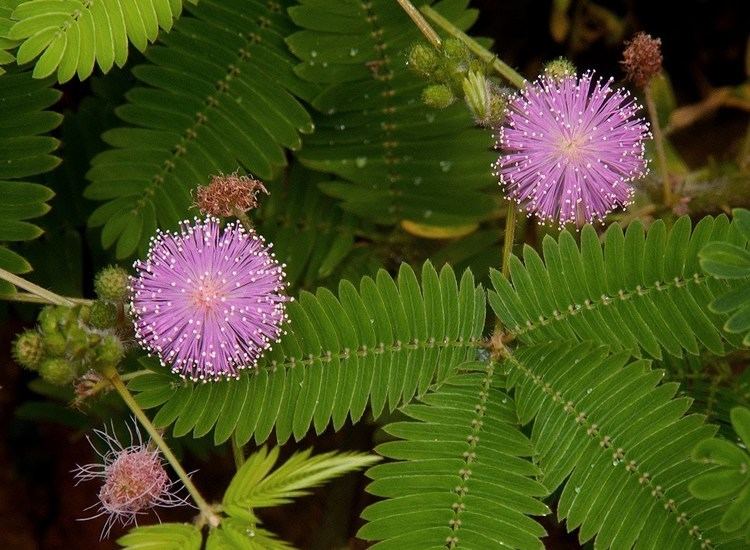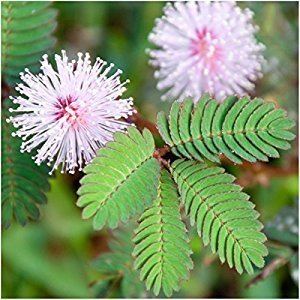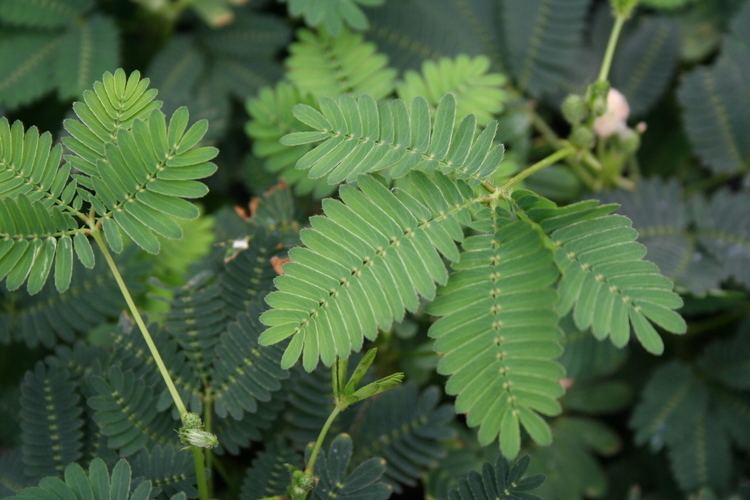Rank Species | Subfamily Mimosoideae Scientific name Mimosa pudica Higher classification Sensitive plant | |
 | ||
Conservation status Least Concern (Population stable) Similar Sensitive plant, Persian silk tree, Legumes, Venus flytrap, Mimosoideae | ||
Mimosa pudica the sensitive plant
Mimosa pudica (from Latin: pudica "shy, bashful or shrinking"; also called sensitive plant, sleepy plant, Dormilones, touch-me-not, or shy plant) is a creeping annual or perennial herb of the pea family Fabaceae often grown for its curiosity value: the compound leaves fold inward and droop when touched or shaken, defending themselves from harm, and re-open a few minutes later. The species is native to South America and Central America, but is now a pantropical weed. It can also be found in Asia in countries such as Bangladesh, Thailand, India, Indonesia, Malaysia, Philippines, and Japan. It grows mostly in undisturbed shady areas, under trees or shrubs.
Contents
- Mimosa pudica the sensitive plant
- Mimosa pudica sensitive plant
- Taxonomy
- Description
- Plant movement
- Distribution and habitat
- Agricultural impacts
- Nitrogen fixation
- Cultivation
- Chemical constituents
- References

Mimosa pudica sensitive plant
Taxonomy

Mimosa pudica was first formally described by Carl Linnaeus in Species Plantarum in 1753. The species epithet, pudica, is Latin for "bashful" or "shrinking", alluding to its shrinking reaction to contact.
The species is known by numerous common names including sensitive plant, humble plant, shameplant, and touch-me-not.
Description

The stem is erect in young plants, but becomes creeping or trailing with age. It can hang very low and become floppy. The stem is slender, branching, and sparsely to densely prickly, growing to a length of 1.5 m (5 ft).
The leaves are bipinnately compound, with one or two pinnae pairs, and 10–26 leaflets per pinna. The petioles are also prickly. Pedunculate (stalked) pale pink or purple flower heads arise from the leaf axils in mid summer with more and more flowers as the plant gets older. The globose to ovoid heads are 8–10 mm in diameter (excluding the stamens). On close examination, it is seen that the floret petals are red in their upper part and the filaments are pink to lavender. The fruit consists of clusters of 2–8 pods from 1–2 cm long each, these being prickly on the margins. The pods break into 2–5 segments and contain pale brown seeds some 2.5 mm long. The flowers are pollinated by the wind and insects. The seeds have hard seed coats which restrict germination.
The roots of Mimosa pudica create carbon disulfide, which prevents certain pathogenic and mycorrhizal fungi from growing within the plant’s rhizosphere. This allows the formation of nodules on the roots of the plant that contain endosymbiotic diazotrophs, which fix atmospheric nitrogen and convert it into a form that is usable by the plant.
Mimosa pudica is a tetraploid (2n = 52).
Plant movement
Mimosa pudica is well known for its rapid plant movement. Like a number of other plant species, it undergoes changes in leaf orientation termed "sleep" or nyctinastic movement. The foliage closes during darkness and reopens in light. This was first studied by the French scientist Jean-Jacques d'Ortous de Mairan.
The leaflets also close when stimulated in other ways, such as touching, warming, blowing, or shaking. These types of movements have been termed seismonastic movements. The stimulus is transmitted as an action potential from a stimulated leaflet, to the leaflet's swollen base (pulvinus), and from there to the pulvini of the other leaflets, which run along the length of the leaf's rachis. The action potential then passes into the petiole, and finally to the large pulvinus at the end of the petiole, where the leaf attaches to the stem. The action potential causes potassium ions to flow out from the vacuoles of cells in the various pulvini. This causes water to flow out from those cells by osmosis through aquaporin channels, making them lose turgor, which is the force that is applied onto the cell wall by water within the cell. Differences in turgidity in different regions of the leaf and stem results in the closing of the leaflets and the collapse of the leaf petiole.
This movement of folding inwards is energetically costly for the plant and also interferes with the process of photosynthesis. This characteristic is quite common within the Mimosoideae subfamily of the legume family, Fabaceae. The stimulus can also be transmitted to neighboring leaves. It is not known exactly why Mimosa pudica evolved this trait, but many scientists think that the plant uses its ability to shrink as a defense from herbivores. Animals may be afraid of a fast moving plant and would rather eat a less active one. Another possible explanation is that the sudden movement dislodges harmful insects.
Distribution and habitat
Mimosa pudica is native to South America, North America and Central America. It has been introduced to many other regions and is regarded as an invasive species in Tanzania, South Asia and South East Asia and many Pacific Islands. It is regarded as invasive in parts of Australia and is a declared weed in the Northern Territory, and Western Australia although not naturalized there. Control is recommended in Queensland. It has also been introduced to Ghana, Nigeria, Seychelles, Mauritius and East Asia but is not regarded as invasive in those places. In the United States of America, it grows in Florida, Hawaii, Tennessee, Virginia, Maryland, Puerto Rico, Texas, Alabama, Mississippi, North Carolina, Georgia, and the Virgin Islands, as well as Cuba and the Dominican Republic.
Agricultural impacts
The species can be a troublesome weed in tropical crops, particularly when fields are hand cultivated. Crops it tends to affect are corn, coconuts, tomatoes, cotton, coffee, bananas, soybeans, papaya, and sugar cane. Dry thickets may become a fire hazard. In some cases it has become a forage plant although the variety in Hawaii is reported to be toxic to livestock.
In addition, Mimosa pudica can change the physico-chemical properties of the soil it invades. For example, the total N and K increased in significantly invaded areas.
Nitrogen fixation
Mimosa pudica can form root nodules that are habitable by nitrogen-fixing bacteria. The bacteria are able to convert atmospheric nitrogen, which plants cannot use, into a form that plants can use. This trait is common among plants in the Fabaceae family. Nitrogen is a vital element for both plant growth and reproduction. Nitrogen is also essential for plant photosynthesis because it is a component of chlorophyll. Nitrogen fixation contributes nitrogen to the plant and to the soil surrounding the plant's roots.
Mimosa pudica’s ability to fix nitrogen may have arisen in conjunction with the evolution of nitrogen-fixing bacteria. Nitrogen fixation is an adaptive trait that has transformed the parasitic relationship between the bacteria and plants into a mutualistic relationship. The shifting dynamics of this relationship are demonstrated by the corresponding improvement of various symbiotic characteristics in both Mimosa pudica and bacteria. These traits include enhanced “competitive nodulation, nodule development, intracellular infection, and bacteroid persistence”. As much as 60% of the nitrogen found in Mimosa pudica can be attributed to the fixation of N2 by bacteria. Burkholderia phymatum STM815T and Cupriavidus taiwanensis LMG19424T are beta-rhizobial strains of diazotrophs that are highly effective at fixing nitrogen when coupled with M. pudica. Burkholderia is also shown to be a strong symbiont of Mimosa pudica in nitrogen-poor soils in regions like Cerrado and Caatinga.
Cultivation
In cultivation, this plant is most often grown as an indoor annual, but is also grown for groundcover. Propagation is generally by seed. Mimosa pudica grows most effectively in nutrient poor soil that allows for substantial water drainage. However, this plant is also shown to grow in scalped and eroded subsoils. Typically, disrupted soil is necessary in order for M. pudica to become established in an area. Additionally, the plant is shade intolerant and frost-sensitive, meaning that it does not tolerate low levels of light or cold temperatures. Mimosa pudica does not compete for resources with larger foliage or forest canopy undergrowth.
Chemical constituents
Mimosa pudica contains the toxic alkaloid mimosine, which has been found to also have antiproliferative and apoptotic effects. The extracts of Mimosa pudica immobilize the filariform larvae of Strongyloides stercoralis in less than one hour. Aqueous extracts of the roots of the plant have shown significant neutralizing effects in the lethality of the venom of the monocled cobra (Naja kaouthia). It appears to inhibit the myotoxicity and enzyme activity of cobra venom.
Mimosa pudica demonstrates both antioxidant and antibacterial properties. This plant has also been demonstrated to be non-toxic in brine shrimp lethality tests, which suggests that M. pudica has low levels of toxicity. Chemical analysis has shown that Mimosa pudica contains various compounds, including “alkaloids, flavonoid C-glycosides, sterols, terenoids, tannins, and fatty acids”. The roots of the plant have been shown to contain up to 10% tannin. A substance similar to adrenaline has been found within the plant's leaves. Mimosa pudica's seeds produce mucilage made up of D-glucuronic acid and D-xylose. Additionally, extracts of M. pudica have been shown to contain crocetin-dimethylester, tubulin, and green-yellow fatty oils. A new class of phytohormone turgorines, which are derivatives of gallic acid 4-O-(β-D-glucopyranosyl-6'-sulfate), have been discovered within the plant.
The nitrogen-fixing properties of Mimosa pudica contribute to a high nitrogen content within the plant’s leaves. The leaves of M. pudica also contain a wide range of carbon to mineral content, as well as, a large variation in 13C values. The correlation between these two numbers suggests that significant ecological adaptation has occurred among the varieties of M. pudica in Brazil.
The roots contain sac-like structures that release organic and organosulfur compounds including SO2, methylsulfinic acid, pyruvic acid, lactic acid, ethanesulfinic acid, propane sulfinic acid, 2-mercaptoaniline, S-propyl propane 1-thiosulfinate, and thioformaldehyde, an elusive and highly unstable compound never before reported to be emitted by a plant.
